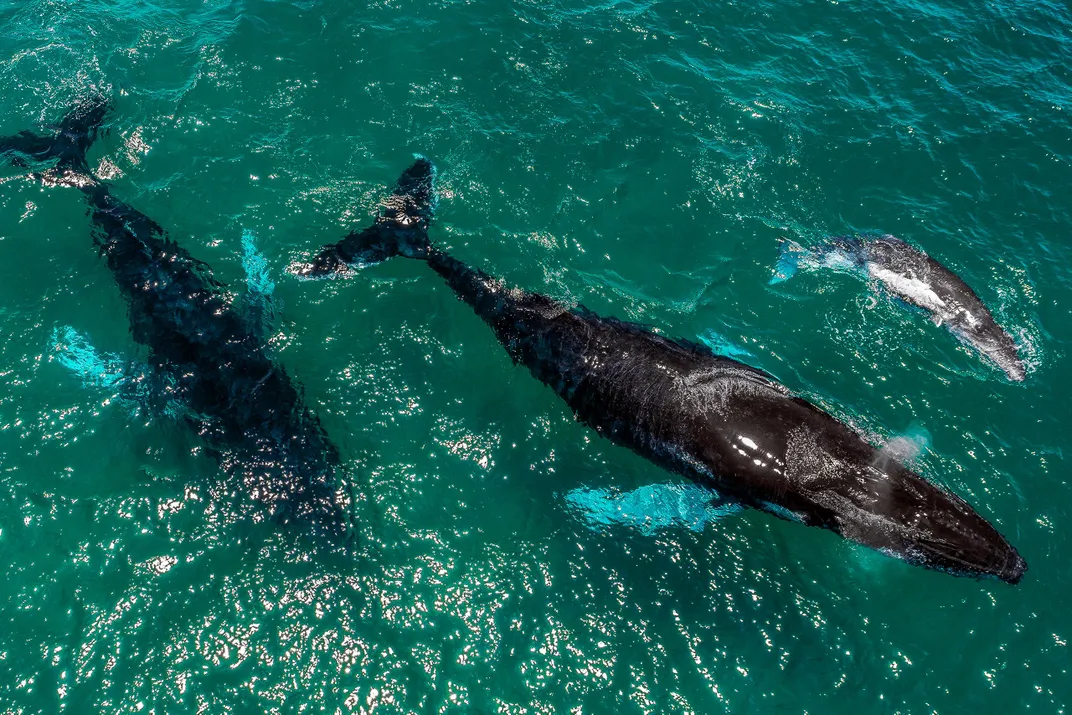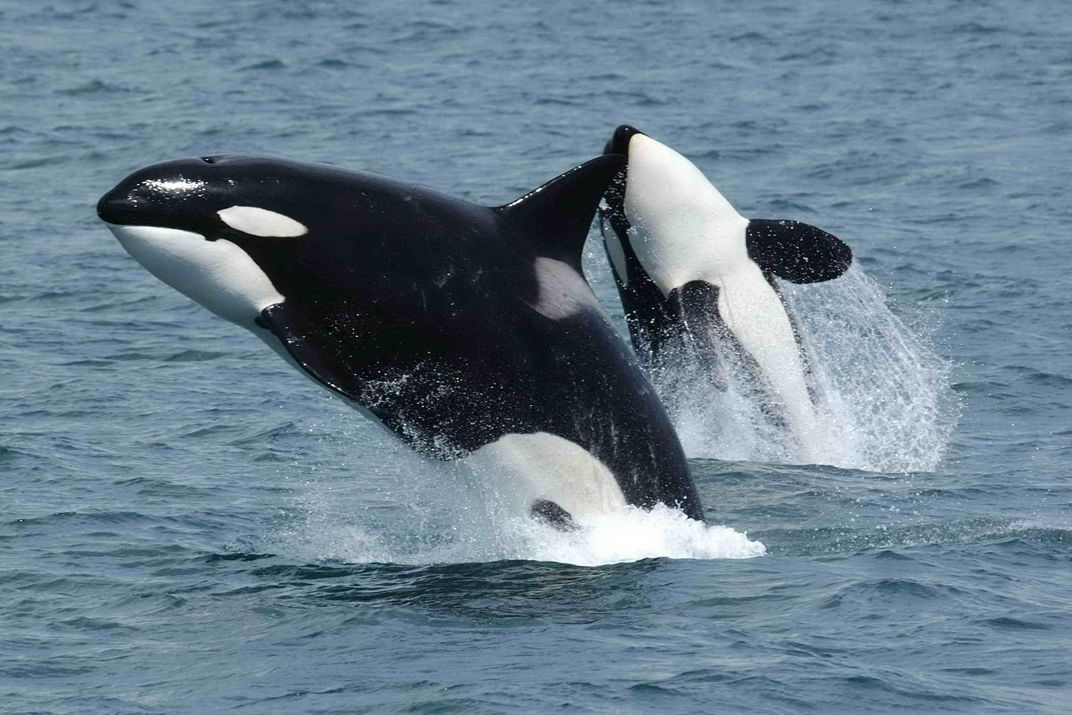With Humans Out of the Way, Humpbacks Are Flourishing—But So Are Orcas
Researchers are just now beginning to understand what happens when one whale species attacks another
:focal(1304x719:1305x720)/https://tf-cmsv2-smithsonianmag-media.s3.amazonaws.com/filer/b9/c9/b9c9cbc5-ae84-459b-9b42-ec71bb6ff062/whale_fluke_unknown.jpg)
The tail of a humpback whale has a tale to tell. Technically called a fluke, a whale’s tail is like a fingerprint: its markings are unique to each individual. Among distinct patterns of black and white pigmentation are scars that detail their stories of survival. Scars left by the teeth of orcas, sharks and other marine predators scraping across the skin are known as rake marks. On other sea creatures, these marks disappear with time, but humpbacks earn these scarred stripes when they’re young and vulnerable and they wear them for life. New research shows that these attacks may be increasing in the eastern South Pacific and Antarctic Peninsula.
In a study published last month in the journal Endangered Species Research, a team of South American marine ecologists and biologists analyzed images of flukes captured in the region from 1986 to 2015. These pictures accounted for a sample of 2,909 adult humpback whales and 133 calves from five breeding zones and two seasonal feeding locations. The team selected images showing flukes fully in focus so that rake marks could be distinctly attributed to killer whales, narrowing their data to identify 361 individuals with visible rake marks on their flukes. Humpback whales typically breed along the coastlines from Costa Rica to northern Peru. Once their calves are a few months old, they begin traveling southward toward popular feeding areas in the Magellan Straits near southern Chile and the Gerlache Strait in the western Antarctic Peninsula.
Humpback behavior in this area is fairly well-studied and easily predictable, says marine ecologist and co-author Hector Guzman of the Smithsonian Tropical Research Institute. But the same cannot be said for orcas, popularly known as killer whales. Although, he says, the results of the team’s analysis could be indicating that there is an increased presence of orcas in the eastern South Pacific, further study is needed to confirm this.
“Everyone believes [orcas] are confined to high latitudes but that’s not true,” says Guzman. “We don’t have much information for the South Pacific population. What we have is more and more reports around the region in tropical and temperate areas that there are more sightings, but that might not be enough [to say the orca population is growing.]”

What the researchers do know is that humpbacks in the region have steadily recovered from centuries of intense whaling. In the 20th century alone, the whaling industry wiped out an estimated 2.9 million large whales. After a moratorium on whaling was put in place in 1985, humpbacks recovered so spectacularly that some call the gentle giants conservation’s “poster child.” Today, nine of 14 populations worldwide no longer require protection under the Endanger Species Act, but remain protected under other federal regulations like the Marine Mammal Protection Act.
While whaling was in its prime, rather than feasting on the easy-to-kill, clumsy calves of other whale species, marine apex predators like the orca had to find alternatives sources of food. Today, orcas seem to have proved that they were far from short on options, feeding on more than 20 species of cetaceans, or marine mammals, adapting to a diversified diet.
Now, however, in places like western Australia, where humpback populations exceed 20,000 individuals, researchers expect to soon see killer whales return and humpback calf predation increase. And, so far, that’s exactly what has happened, says marine ecologist Robert Pitman of the National Oceanic and Atmospheric Association Fisheries division based in California, who authored a study about orcas and humpbacks in western Australia in 2015.
Guzman and his team seem to have come to a similar conclusion: “Calves showed a significant increase in the probability of having rake marks during the study period compared to adults, which suggests an increase in predation pressure over time,” the study says.
Furthermore, orcas in the eastern South Pacific and Antarctic Peninsula seem to be behaving similarly to other populations around the world. In total, about 11.5 percent of adults had rake marks on their flukes compared to 19.5 percent of calves, and these numbers are similar to what’s been reported in populations worldwide.

Perhaps most striking is that only 9 percent of calves at breeding sites had scars, compared to a whopping 34 percent at feeding sites. These scars on their flukes are vivid illustrations of a treacherous journey of survival during their first migration.
Rake marks on humpback flukes may be literal tallies of battles won, but little is known about the losses.
“During their first migration, they’re getting bigger. These are calves that got just big enough that they were able to get away,” says Pitman, who was not involved in the recent study. “I think what happens is when [killer whales] attack young calves, they get them. When they are very young, I don’t think those calves are difficult to take on.”
Almost no new scars were seen on humpback whales into adulthood. The authors also noted in the study that female calves that obtained rake marks became mothers that were better at defending their calves from killer whales. Although, it may be possible that the orcas are striking the adult’s underside—somewhere researchers would have a difficult time seeing, Guzman notes. But that’s still quite risky.
“Killer whales don’t want to be anywhere around the tail of a grown humpback. It’s a lethal weapon,” Pitman says. “That’s probably why they don’t acquire additional rake marks on adult flukes. When killer whales are around adult humpbacks, whether they’re with a calf or not, they respect the tail. The flippers can weigh a ton and those are not nearly as big as the flukes.”
The new research is the first and largest of its kind to study clashes between humpback whales and killer whales in this part of the world, yet Guzman maintains there is still so much work to be done, especially about orcas in that region. Pitman agrees, noting that the whaling industry has proved to be a kind of a scientific “wrench in the works” in understanding this pattern of predation and we’re just now getting a glimpse of how the oceans operated before that time.
“We don’t really know what marine ecology looks like with a full set of whales. By the time we started studying them, the oceans had been emptied of whales, and as they return, we might see a lot of new behaviors from prey and predators,” says Pitman. “This is an unintended experiment running in real time.”
/https://tf-cmsv2-smithsonianmag-media.s3.amazonaws.com/accounts/headshot/rachael.png)
/https://tf-cmsv2-smithsonianmag-media.s3.amazonaws.com/accounts/headshot/rachael.png)